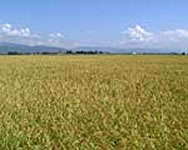|
|
|
|
|
Report
No.230709 |
|
|
|
|
|
||
|
Restore 'Cradle for Living Creatures' - 'Paddy Field Renaissance'
In February 1999 then Environment Agency made a shocking announcement to say that Medaka was on the verge of extinction. Its scientific name [Oryzias Latipes] means 'a (tiny) fish with broad fin that lives in paddy fields' and it is a fish that indeed represents Japan's agriculture. Decrease in its population is considered to have been caused by the gap in height erected between cannel and paddy field, with the gap having been built by the field consolidation works, making it difficult for the tiny fishes to come and go between them. At the same time, population of frogs and loaches has also declined likewise, and the status of living creatures found in Satoyama [neighborhood village, woodlands and fields from which to harvest firewood and green manures] has largely changed. It was under such circumstances that movements to restore the natural environment started and developed to the point of moving the government. The prefecture government of Shiga, one which has Lake Biwa, the largest inland lake in the country, is about to launch a program of direct payment which will be made to paddy fields that will have been re-done to allow fishes to travel upstream to lay eggs. In the years past, paddy fields around the lake used to be place of multiplication of gibel (unique fish to the Lake), which was used as ingredient in making Gibel Sushi. When paddy fields regain their glow, so also will the food culture associated with it. In Fukuoka prefecture, one of the advanced in reduced application of farm chemicals campaign, people are continuing efforts to list up living creatures that could serve as a guidepost in setting criteria for making direct payments. Participating farmers have been caught with surprise to find that such a large variety of creatures live on paddy fields and have been made to understand why paddy fields are called 'cradle for living creatures.' JA Zennoh (the national federation of JA associations) also plans to promote more widely the field creature survey as a part of their SR (social responsibility) activities. In the Lake Tazawa of Akita prefecture, an indigenous trout, Kuni-Masu, used to live in the years past. This trout species is extinct now as the only habitat on earth for them was destroyed, caused by strong acid water introduced in the name of land reclamation for agriculture and of the development of electric power resources. Record puts that the species had been released in other lakes in advance and even prize money was offered to find them, only to learn that what was lost once is hard to restore. We do not know for sure how much ability of recovery the nature has. Yet, we are witnessing the disappearance, caused by destruction of forest and depletion of ozone layers, of what used to be around us, of which existence was taken for granted, one after the other. Some academics say that around 100 different species disappear from earth in a day and that the speed of extinction has picked up to 40 thousand times as quick during the last century. Certainly, the value of water is being given more recognition these days, and yet one must recognize that paddy fields and Satoyama are equally valuable. It is difficult to find value in what was once disregarded of its value. However, paddy fields are not a factory for food production. They are where the hearts of Japanese come back to for rest and also where the vast variety of living creature find a cradle for them. Let us give high evaluation to the idea of 'Paddy Field Renaissance' for having made the first step forward and hope that it will be followed by the next steps. (from an editorial in the February 25, 2006 issue of the Nihon Nogyo Shinbun) |
|||
|
|
|||
